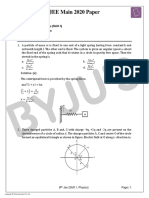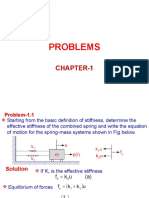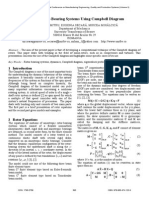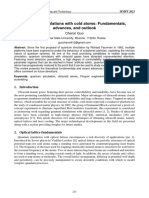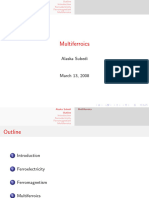Homework 5
Uploaded by
홍인기Homework 5
Uploaded by
홍인기Homework 5
1. Consider N spins in a chain which can be model using the one-dimensional Ising
model
-
i 1
-1
o
i
o
i-1
where the spin has the values o
i
1.
a) Find the partition function.
b) Find the heat capacity per spin.
2. Assume three spins are arranged in an equilateral triangle with each spin
interacting with its two neighbors. The energy expression for the Ising model in a
magnetic field ( ) is
-(o
1
o
2
-o
2
o
8
-o
8
o
1
)-(o
1
-o
2
-o
8
)
Derive equations for the
a) Partition function
b) Average spin <o
c) Internal energy
(Express answers using hyperbolic trigonometric functions)
3, 4, 5, 6
Solve problem 2, 4, 6 and 7 in Chapter 12 of your textbook.
You might also like
- Cls Jeead-18-19 Xiii Phy Target-2 Set-1 Chapter-5No ratings yetCls Jeead-18-19 Xiii Phy Target-2 Set-1 Chapter-5104 pages
- Elements of Mechanical Engineering Rme 101No ratings yetElements of Mechanical Engineering Rme 1013 pages
- Instructions: Enter Your Examination Centre HereNo ratings yetInstructions: Enter Your Examination Centre Here4 pages
- Nanoscale Engineering: Written Qualifying Exam Winter/Spring 2013 Day 1 January 23, 2013No ratings yetNanoscale Engineering: Written Qualifying Exam Winter/Spring 2013 Day 1 January 23, 201323 pages
- Nanoscale Engineering: Written Qualifying Exam Fall 2019 Day 1 August 26, 2019No ratings yetNanoscale Engineering: Written Qualifying Exam Fall 2019 Day 1 August 26, 201927 pages
- Tutorial 2 - Statistical Thermodynamics 2No ratings yetTutorial 2 - Statistical Thermodynamics 211 pages
- PHY2004W 2019 June Final Examination _CM_No ratings yetPHY2004W 2019 June Final Examination _CM_5 pages
- SCORE300 Test Series 2025 T13 (Code a) QuestionNo ratings yetSCORE300 Test Series 2025 T13 (Code a) Question12 pages
- Sample For Solution Manual Dynamics of Structures 5th SI Edition by Anil ChopraNo ratings yetSample For Solution Manual Dynamics of Structures 5th SI Edition by Anil Chopra20 pages
- Btech 1 Sem Elements of Mechanical Engineering Rme 101 2017 18No ratings yetBtech 1 Sem Elements of Mechanical Engineering Rme 101 2017 183 pages
- Study of Rotor-Bearing Systems Using Campbell DiagramNo ratings yetStudy of Rotor-Bearing Systems Using Campbell Diagram4 pages
- Assignments On Nuclear and Particle Physics Full SyllabusNo ratings yetAssignments On Nuclear and Particle Physics Full Syllabus4 pages
- Physics March2019 B E Withcredits RegularJune-2018PatternFE DDF3F8EFNo ratings yetPhysics March2019 B E Withcredits RegularJune-2018PatternFE DDF3F8EF2 pages
- Studying The Nuclear Structure of Even-Even Deformed Germanium NucleusNo ratings yetStudying The Nuclear Structure of Even-Even Deformed Germanium Nucleus9 pages
- 07MA6005 Mathematical Methods in Structural Engineering DEC 2015No ratings yet07MA6005 Mathematical Methods in Structural Engineering DEC 20153 pages
- 91a2aa3c-f532-4d6b-a40c-67f6b2e6ee2d.pdfNo ratings yet91a2aa3c-f532-4d6b-a40c-67f6b2e6ee2d.pdf2 pages
- Factoring and Algebra - A Selection of Classic Mathematical Articles Containing Examples and Exercises on the Subject of Algebra (Mathematics Series)From EverandFactoring and Algebra - A Selection of Classic Mathematical Articles Containing Examples and Exercises on the Subject of Algebra (Mathematics Series)No ratings yet
- Blackbody Emission: Homework Due Today Put in Alphabetical Boxes at The Back of The RoomNo ratings yetBlackbody Emission: Homework Due Today Put in Alphabetical Boxes at The Back of The Room28 pages
- BE Electronic & Comunication 2016 RCOEM SyllabusNo ratings yetBE Electronic & Comunication 2016 RCOEM Syllabus63 pages
- Quantum Simulations With Cold Atoms Fundamentals ANo ratings yetQuantum Simulations With Cold Atoms Fundamentals A6 pages
- Complete Download Computational Organic Chemistry 1st Edition Steven M. Bachrach PDF All Chapters100% (2)Complete Download Computational Organic Chemistry 1st Edition Steven M. Bachrach PDF All Chapters67 pages
- The Principles of Quantum Theory, From Planck's Quanta To The Higgs Boson - The Nature of Quantum Reality and The Spirit of Copenhagen (PDFDrive)No ratings yetThe Principles of Quantum Theory, From Planck's Quanta To The Higgs Boson - The Nature of Quantum Reality and The Spirit of Copenhagen (PDFDrive)341 pages
- 64328a21fdee93001837c535 - ## - Arjuna JEE 2024 - PHYSICAL CHEMISTRYNo ratings yet64328a21fdee93001837c535 - ## - Arjuna JEE 2024 - PHYSICAL CHEMISTRY2 pages
- Holubova 2024 J. Phys. Conf. Ser. 2715 012003No ratings yetHolubova 2024 J. Phys. Conf. Ser. 2715 0120038 pages
- International Journal of Quantum Chemistry - 1987 - 32No ratings yetInternational Journal of Quantum Chemistry - 1987 - 325 pages
- Konfigurationsraum Und Zweite QuantelungNo ratings yetKonfigurationsraum Und Zweite Quantelung5 pages
- History and Some Aspects of The Lamb Shift: G. Jordan MaclayNo ratings yetHistory and Some Aspects of The Lamb Shift: G. Jordan Maclay45 pages
- The Two Slit Experiment: 4.1 An Experiment With BulletsNo ratings yetThe Two Slit Experiment: 4.1 An Experiment With Bullets10 pages
- Letran de Davao, Inc.: High School DepartmentNo ratings yetLetran de Davao, Inc.: High School Department2 pages













